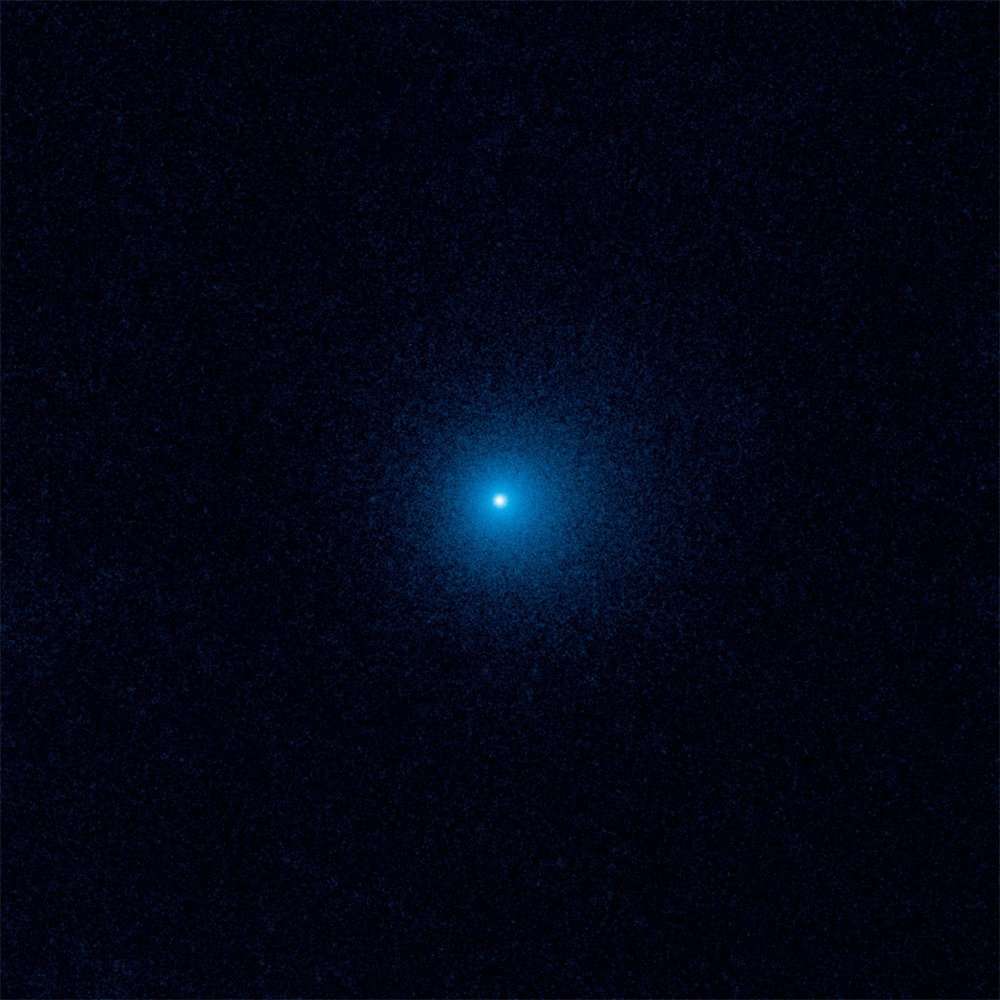A new image reveals a distant newcomer to our solar system: the farthest active comet ever spotted, heading toward the sun for the first time.
The Hubble Space Telescope captured a view of Comet C/2017 K2 (PANSTARRS), called K2 for short, as it came in from out beyond Saturn's orbit, 1.5 billion miles from the sun. As it approaches the sun and the temperature rises from minus 440 degrees Fahrenheit, the comet is developing a fluffy cloud of dust, called a coma, which surrounds its frozen body. While the comet's nucleus appears to be just 12 miles across, the coma stretches 10 times Earth's diameter.
According to a statement from NASA, K2 likely began its journey in the spherical Oort Cloud surrounding the solar system, which hosts hundreds of billions of comets and stretches almost a light-year across. Because it's the comet's first trip into the solar system, its composition could reflect conditions in the early system, before planets formed. [Photos: Spectacular Comet Views from Earth and Space]
A newfound distant comet — 1.5 billion miles from the sun — boasts the earliest signs of activity ever seen on a comet entering the solar system. Credit: D. Jewitt/NASA/ESA/UCLA
The comet's fuzzy halo likely comes from substances such as oxygen, nitrogen, carbon dioxide and carbon monoxide turning from solid to gas as the comet approaches the sun's warmth for the first time.
"I think these volatiles are spread all through K2, and in the beginning billions of years ago, they were probably all through every comet presently in the Oort Cloud," David Jewitt, lead author on the study and a researcher at the University of California, Los Angeles, said in the statement. "But the volatiles on the surface are the ones that absorb the heat from the sun, so, in a sense, the comet is shedding its outer skin."
"Most comets are discovered much closer to the sun, near Jupiter's orbit, so by the time we see them, these surface volatiles have already been baked off," he added. "That's why I think K2 is the most primitive comet we've seen." Most comets' comas come from evaporating water and ice, but K2 is too far from the sun for that process to have begun.
Comet C/2017 K2 (PANSTARRS), also known as K2, on its first journey into the Solar System. The comet was observed halfway between the orbits of Saturn and Uranus (Pluto is the furthest orbit visible in the image). Credit: A. Field/NASA/ESA/STScl
Researchers first spotted K2 in May 2017 with data from the Panoramic Survey Telescope and Rapid Response System (Pan-STARRS). The new Hubble view let Jewitt's team measure the size of K2's nucleus and confirm that it hasn't yet developed a comet's signature tail.
They also spotted K2 in earlier images, gathered in 2013 by the Canada-France-Hawaii Telescope (CFHT) in Hawaii; at the time, nobody had noticed the incredibly faint object, according to the statement, but Jewitt's team was able to identify the comet and its growing coma of material.
"We think the comet has been continuously active for at least four years," Jewitt said. "In the CFHT data, K2 had a coma already at 2 billion miles from the sun, when it was between the orbits of Uranus and Neptune. It was already active, and I think it has been continuously active coming in."
"As it approaches the sun, it's getting warmer and warmer, and the activity is ramping up," he added.
Over the next five years, the comet will travel closer to the sun, allowing researchers to follow its journey — it will approach closest to the sun in 2022, just outside Mars' orbit.
"We will be able to monitor for the first time the developing activity of a comet falling in from the Oort Cloud over an extraordinary range of distances," Jewitt said. "It should become more and more active as it nears the sun and presumably will form a tail."
The new work was detailed Sept. 28 in The Astrophysical Journal Letters.
Email Sarah Lewin at [email protected] or follow her @SarahExplains. Follow us @Spacedotcom, Facebook and Google+. Original article on Space.com.

___OP____ on September 30th, 2017 at 06:09 UTC »
Who wants to hitchhike on this one? I'm down for a interstellar voyage with a gang of rowdy space cowboys.
enoch33rd on September 30th, 2017 at 04:28 UTC »
Hope this will be visible. Been a while since I saw a comet.
Upthepalace1 on September 30th, 2017 at 04:19 UTC »
Anyone know how visible it'll be from earth yet?